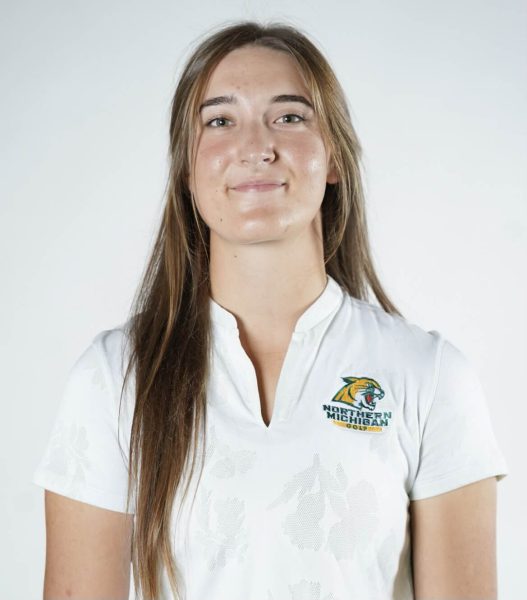Alumni profile — Diane Husic restores nature at the Lehigh Gap Wildlife Refuge
Diane Husic (second from left) travels with her students to give them hands-on research opportunities. Her current work is at the Lehigh Gap Wildlife Refuge where she and her students monitor the life coming back to the contaminated environment.
March 15, 2022
In her intro to environmental science course at Moravian University in Pennsylvania, Diane Husic took first-year college students on a field trip to the Lehigh Gap Wildlife Refuge, a site that has undergone the process of revegetation, being partially remedied and restored of toxic metals.
For a time, the refuge had no bacteria, plants or insects until researchers began using prairie plants and grasses that are able to grow in the soil contaminated with heavy metals.
“We know that this project is going to be successful when we start seeing the first insects,” Husic said.
In the class, Husic had the students get on their stomachs in the grass and look for insects.
“It was sort of the fall when the monarchs migrate and all of a sudden somebody saw a grasshopper and somebody saw a monarch flying through,” Husic said. “They were so inspired that they had discovered the first insects.”
Seeing the insects made the students feel like discoverers, said Husic.
“I love opening their eyes and getting students out in nature,” Husic said. “So those moments of watching, that awe, really, I will never forget those moments.”
Taking students birding or having them walk through the restored property shows them there are these moments of hope, Husic said.
Husic is a Northern Michigan University alumni from the class of 1981 and dean of the School of Natural and Health Sciences at Moravian University in Bethlehem, Pennsylvania. She teaches students a wide range of courses from environmental science to sustainability and climate change.
Inspiring many with her work in environmental action, Husic been committed to her teaching and volunteering projects such as the Lehigh Gap Wildlife Refuge, where she is the current president on the board of directors and advisors.
The 750-acre Lehigh Gap Wildlife Refuge is part of the Environmental Protection Agency’s Palmerton Zinc Pile Superfund Site. It is contaminated by the nearby Zinc Smelter Operations that is across the river from an industrial site.
The refuge offers visitors a trail system providing 13 miles of hiking trails. The goal of the restoration project and in the Lehigh Gap Wildlife Refuge Ecological Assessment, an assessment to guide current and future restoration efforts, was to reestablish the contaminated site, keeping the metals from polluting rivers, the wildlife and for human health.
“We can take an area that we thought was just beyond pollution, never going to be recovered and see that it is recovering,” Husic said.
Husic said the EPA and its experts tried everything to promote plant growth at the toxic site, but nothing was working at the time.
“This group of amateurs, a high school teacher and a couple birders that worked at an energy company said, ‘oh, we could probably fix the solution,’” Husic said.
They looked to nature instead of utilizing highly technical results, finding the solution by merely planting prairie grasses, she said.
Prairie grasses are a tall grass that grow well in soils full of metals. The grasses help to build top soil, keeps erosion down and allows other things to grow.
“It’s the idea that you don’t have to be an expert sometimes if you have an idea and you really pay attention to cues in nature and think about how we can help nature heal itself,” Husic said.
During her time at NMU, Husic was a biochemistry major and for a short period swam and dived on the NMU Swim & Dive Team. She found NMU’s strong science programs and research opportunities appealing.
“I was also very, very much interested in environmental topics, more for my hobby,” Husic said.
During her undergraduate studies she took on a project where she looked at oil contaminants on lake surfaces. Husic developed methods of collection involving obtaining the surface monolayer of oils from the water, extracting that sample back in the lab to get the organic chemical fraction and then using gas chromatography methods for separating compounds. Husic’s professor and advisor encouraged her to attend graduate school.
“Northern had great faculty advisors who really worked with students directly and could be those mentors that you needed, especially if I was somebody who was shy and didn’t have a lot of confidence,” Husic said.
She ended up getting her Ph.D. in biochemistry at Michigan State University.
Husic began working with several nonprofits and nature centers including the Lehigh Gap Nature Center and the Nurture Nature Center where she volunteers and partners with artists to find ways to communicate environmental issues and other various initiatives in Pennsylvania.
Husic said her goal is to communicate science to the public and to general audiences, finding ways to develop education programming on environmental and sustainability issues and addressing these through art science and community dialogue.
Husic received the NMU Distinguished Alumni Award in 2013, earning the highest honor the NMU Alumni Association can present to a graduate of the university.
“It was such a surprise and it was such an honor, and I think knowing that the people and the institution that kind of helped direct your path and got you started recognizes your successes, made it extra special,” Husic said.
Husic was on campus to receive the award and had the opportunity to talk about some of the work she had been doing for the science students at NMU. She shared her experiences with being shy throughout college and how Northern boosted her confidence to do her best.
“I think one of the things Northern taught me to do is want to be confident, that I could measure up to anybody and do anything even coming from a smaller town, but also to learn how to recognize when doors open,” Husic said.



























